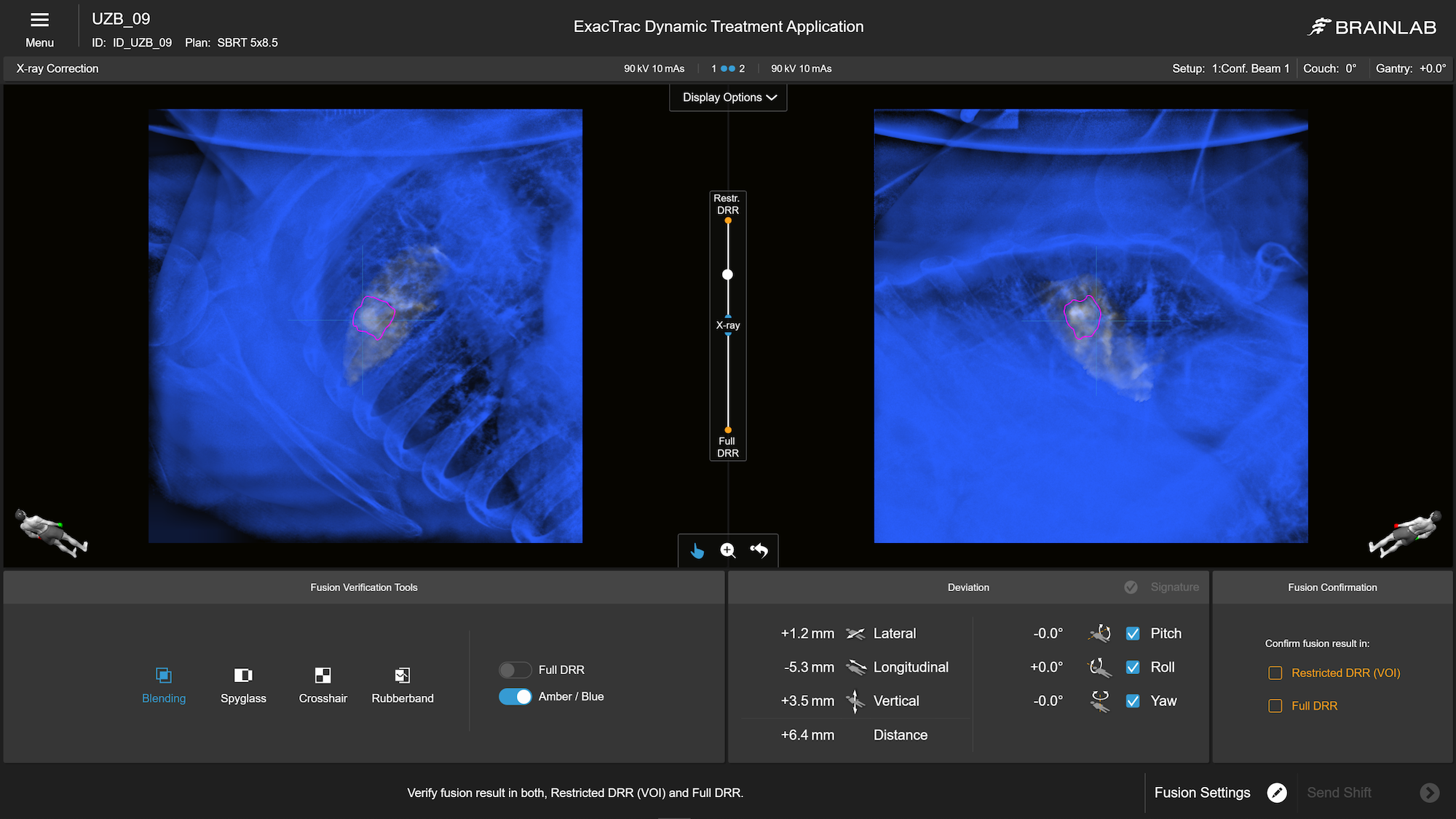Markerless SBRT for lung treatment using ExacTrac Dynamic: a feasibility study
PO-1883
Abstract
Markerless SBRT for lung treatment using ExacTrac Dynamic: a feasibility study
Authors: Thierry Gevaert1, Marlies Boussaer1, Cristina Teixeira1, Tim Everaert2, Adrian Gutiérrez1, Anne-Sophie Bom1, Jelle Smeulders1, Philipp Freislederer3, Kajetan Berlinger4, Mark De Ridder1
1UZ Brussel, Vrije Universiteit Brussel, Radiotherapy, Brussels, Belgium; 2UZ Brussel, Vrije Universiteit Brussel,, Radiotherapy, Brussels, Belgium; 3Brainlab, Brainlab, Munich, Germany; 4Brainlab, R&D, Munchen, Germany
Show Affiliations
Hide Affiliations
Purpose or Objective
Stereotactic body radiotherapy for lung treatments remains typical challenging when applying gating or tracking. The drawback of markerbased techniques is that most patients are not eligible for marker implementation. The ability to visualize and monitor tumor motion without implanted markers is therefore clinically advantageous. In this setup, we wanted to implement a technique eligible for a large variety of patients. Existing markerless methods often suffer from overlapping structures and low visibility due to low tumor tissue contrast. In this study, we want to analyze the feasibility of markerless tumor detection with ExacTrac Dynamic (Brainlab, Munchen, Germany) using surrogate digitally reconstructed radiographs (DRRs) for soft tissue target localization.
Material and Methods
Markerless tumor detection was based on non-clinical patented software (US10776959 BB) which uses surrogate DRR for target identification. The concept is to identify the target in the stereoscopic x-rays by rendering the DRRs with structures that include and move the same way than the target. First an elastic fusion is performed, yielding trajectory for every voxel of the reference bin, of reference bin to other bins is performed. Target coordinates in reference bin are then defined and trajectory for every voxel computed, to identify the similarity to target trajectory. Lastly the rendered surrogate DRR only includes these voxels fulfilling the similarity criteria.
To validate this approach, five consecutive treated SBRT lung patients were analyzed. Patients received a 4DCT simulation for motion analysis and internal target volume creation. Prior to treatment a 4D CBCT was performed for positioning purposes as well as for motion analysis. Stereoscopic x-ray imaging was acquired prior and during treatment. The motion component in cranio–caudal, latero-lateral and antero-posterior direction was assessed and compared to the known tumor motion based on 4DCT and 4DCBCT. 4DCT motion component were used as the ground truth in this feasibility study.
Results
In all 5 cases, the tumors were successfully visualized on the stereoscopic x-rays. The mean motion component across all five patients on the reference 4DCT was 1.3mm (SD 1.1mm), 6.0mm (SD7.7mm) and 3.1mm (SD2.9mm), for latero-lateral, cranio–caudal and antero-posterior direction, respectively. For the 4DCBCT a motion of 0.6mm (SD 0.8mm), 4.0mm (SD4.4mm) and 2.1mm (SD2.8mm) was found, while for our new method using stereoscopic x-rays a motion of 1.5mm (SD 1.1mm), 5.9mm (SD4.5mm) and 3.9mm (SD1.6mm). Possible differences between 4D CT and CBCT are caused due to blurry image of the lesion which makes target definition complicated. Although preliminary, sub millimetric agreement was found between 4DCT and stereoscopic x-rays.
Figure 1 shows the registration between surrogate DRR and x-rays.
Conclusion
These promising results shows the potential of applying surrogate DRR for target localization in stereoscopic x-rays and to implement SBRT in a markerless environment.